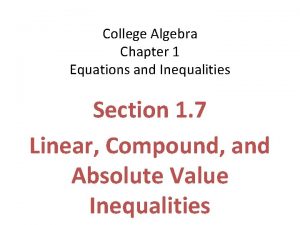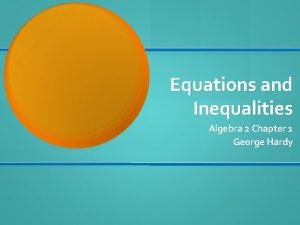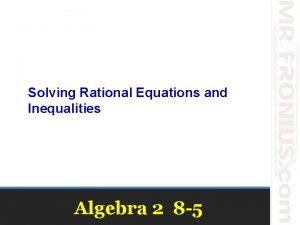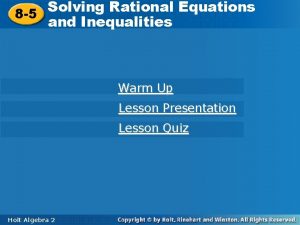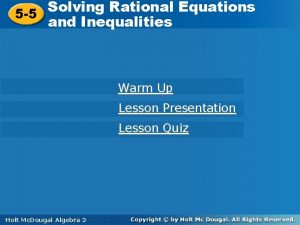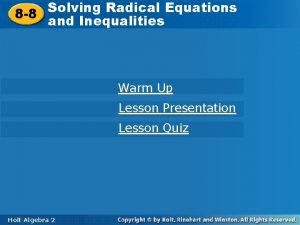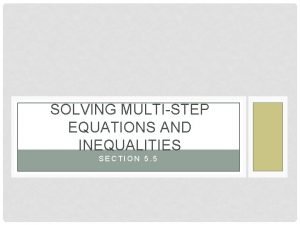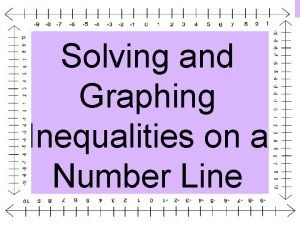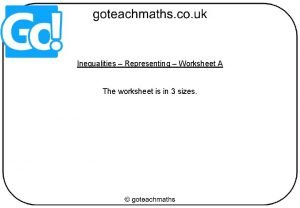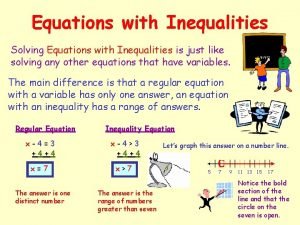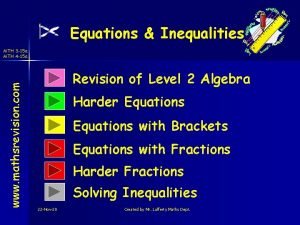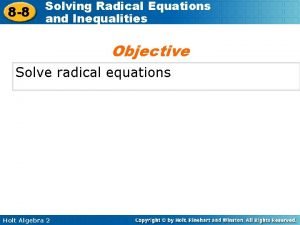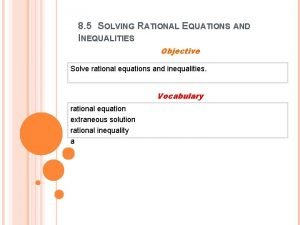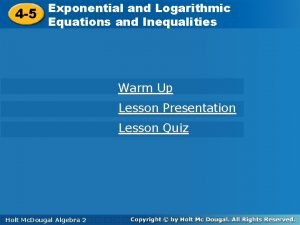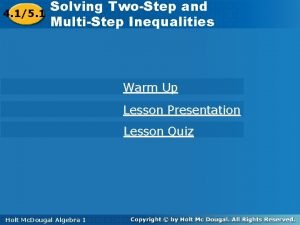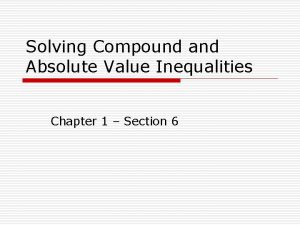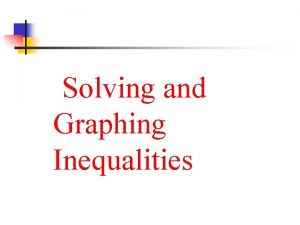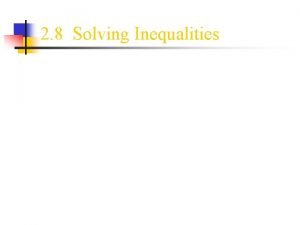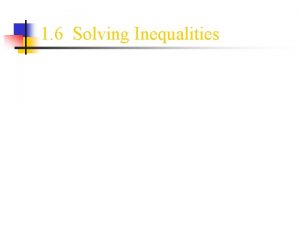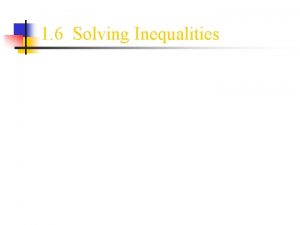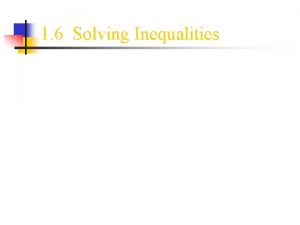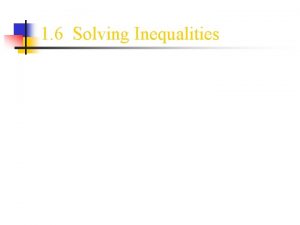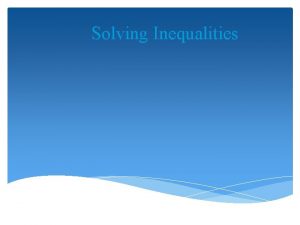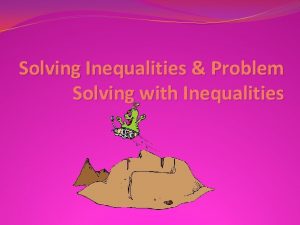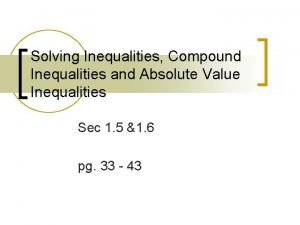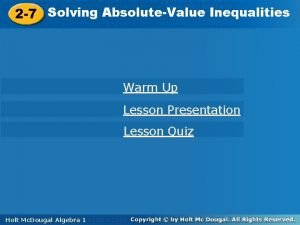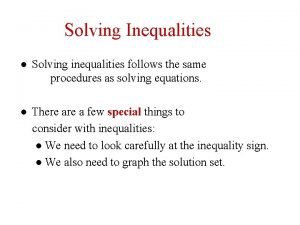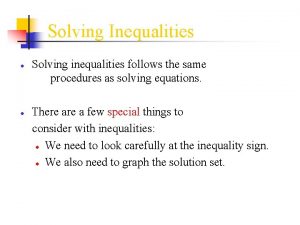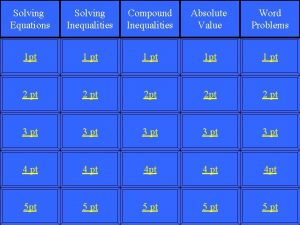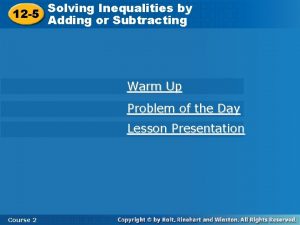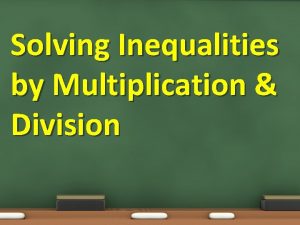Solving Inequalities Chapter 3 3 1 Inequalities and


















- Slides: 18

Solving Inequalities Chapter 3

3. 1 Inequalities and Their Graphs � Pg. 164 – 170 � Obj: Learn how to write, graph, and identify solutions of inequalities. � Content Standard: Prepares for A. REI. 3

3. 1 Inequalities and Their Graphs � Solution of an inequality – any number that makes the inequality true � Representing Inequalities ◦ < or > open circles ◦ < or > closed circles

3. 2 Solving Inequalities Using Addition or Subtraction � Pg. 171 – 177 � Obj: Learn how to use addition or subtraction to solve inequalities. � Content Standards: A. REI. 3 and A. CED. 1

3. 2 Solving Inequalities Using Addition or Subtraction � Equivalent Inequalities – inequalities that have the same solutions � Solving Addition or Subtraction Inequalities ◦ Isolate the variable ◦ Do the opposite operation �Addition – Subtraction �Subtraction – Addition ◦ Whatever you do to one side of the equation, you must do to the other

3. 3 Solving Inequalities Using Multiplication or Division � Pg. 178 – 183 � Obj: Learn how to use multiplication or division to solve inequalities. � Content Standards: A. CED. 1, N. Q. 2, and A. REI. 3

3. 3 Solving Inequalities Using Multiplication or Division � Solving Multiplication or Division Inequalities ◦ Isolate the Variable ◦ Do the opposite operation �Multiplication – Division �Division – Multiplication �If you multiply or divide by a negative, change the direction of the inequality. ◦ Whatever you do to one side, you must do to the other

3. 3 Solving Inequalities Using Multiplication or Division � Concept Byte – Pg. 184 � Properties of Equality ◦ Reflexive Property – a = a ◦ Symmetric Property – If a=b, then b=a ◦ Transitive Property – If a=b and b=c, then a=c � Transitive Property of Inequality ◦ If a<b and b<c, then a<c

3. 4 Solving Multi-Step Inequalities � Pg. 186 – 192 � Obj: Learn how to solve multi-step inequalities. � Content Standards: Prepares for A. REI. 3 and A. CED. 1

3. 4 Solving Multi-Step Inequalities � Solving Inequalities ◦ Use the Distributive Property to remove any grouping symbols ◦ Combine like terms on each side of the inequality ◦ Get the variable terms on one side of the inequality and the constants on the other ◦ Solve for the variable ◦ Check your solution in the original inequality

3. 5 Working With Sets � Pg. 194 – 199 � Obj: Learn how to write sets and identify subsets and find the complement of a set. � Content Standard: A. REI. 3

3. 5 Working With Sets � Roster Form – lists the elements of a set within braces {} – {2, 4, 6, 8, …} � Set-builder notation – describes the properties an element must have to be in included in a set – {x|x is a multiple of 2} – “the set of all real numbers x, such that x is a multiple of 2” � Empty Set – the set that contains no elements � Universal Set – the largest set you are using � Complement of a Set – the set of all elements in the universal set that are not in the set (A’)

3. 6 Compound Inequalities � Pg. 200 – 206 � Obj: Learn how to solve and graph inequalities containing the words “and” or “or”. � Content Standards: A. REI. 3, and A. CED. 1

3. 6 Compound Inequalities � Compound Inequality – consists of two distinct inequalities joined by the and or the word or � Interval notation ◦ Parentheses – Use (or) when a < or > symbol indicates that the interval’s endpoints are not included ◦ Brackets – Use [or] when a < or > symbol indicates that the interval’s endpoints are included ◦ Infinity – Use ∞ when the interval continues forever in a positive direction. Use -∞ when the interval continues forever in a negative direction.

3. 7 Absolute Value Equations and Inequalities � Pg. 207 – 213 � Obj: Learn how to solve equations and inequalities involving absolute value. � Content Standards: A. CED. 1, and A. SSE. 1. b

3. 7 Absolute Value Equations and Inequalities � Solving Absolute Value Equations � Solving Absolute Value Inequalities ◦ Set what is inside the absolute signs equal to both the positive and negative values ◦ Solve each equation and check your solutions ◦ Use method similar to absolute value equations ◦ < or < is an “and” compound inequality ◦ > or > is an “or” compound inequality

3. 8 Unions and Intersections of Sets � Pg. 214 – 220 � Obj: Learn how to find the unions and intersections of sets. � Content Standard: A. CED. 1

3. 8 Unions and Intersections of Sets � Union – the set that contains all elements of the sets (A ∪ B) � Intersection – the set of elements that are common to every set (A ∩ B) � Disjoint Sets – sets that have no elements in common
 Chapter 1 equations and inequalities
Chapter 1 equations and inequalities Algebra 2 chapter 1 equations and inequalities answer key
Algebra 2 chapter 1 equations and inequalities answer key Chapter 3 solving inequalities answer key
Chapter 3 solving inequalities answer key How to solve rational equations and inequalities
How to solve rational equations and inequalities Solve the rational equation 8/x+1/5=3/x
Solve the rational equation 8/x+1/5=3/x 5-5 solving rational equations and inequalities
5-5 solving rational equations and inequalities Practice b solving radical equations and inequalities
Practice b solving radical equations and inequalities Inequalities with radicals
Inequalities with radicals Solving multi step equations and inequalities
Solving multi step equations and inequalities Graphing inequalities on a number line
Graphing inequalities on a number line Solve and graph inequalities worksheet
Solve and graph inequalities worksheet How to solve inequalities
How to solve inequalities Brackets equations and inequalities
Brackets equations and inequalities Solving radical equations and inequalities
Solving radical equations and inequalities Solving rational equations and inequalities
Solving rational equations and inequalities Example of logarithmic inequality
Example of logarithmic inequality Solving two step and multi step inequalities
Solving two step and multi step inequalities 5-5 solving rational equations and inequalities
5-5 solving rational equations and inequalities 1-6 solving compound and absolute value inequalities
1-6 solving compound and absolute value inequalities
